

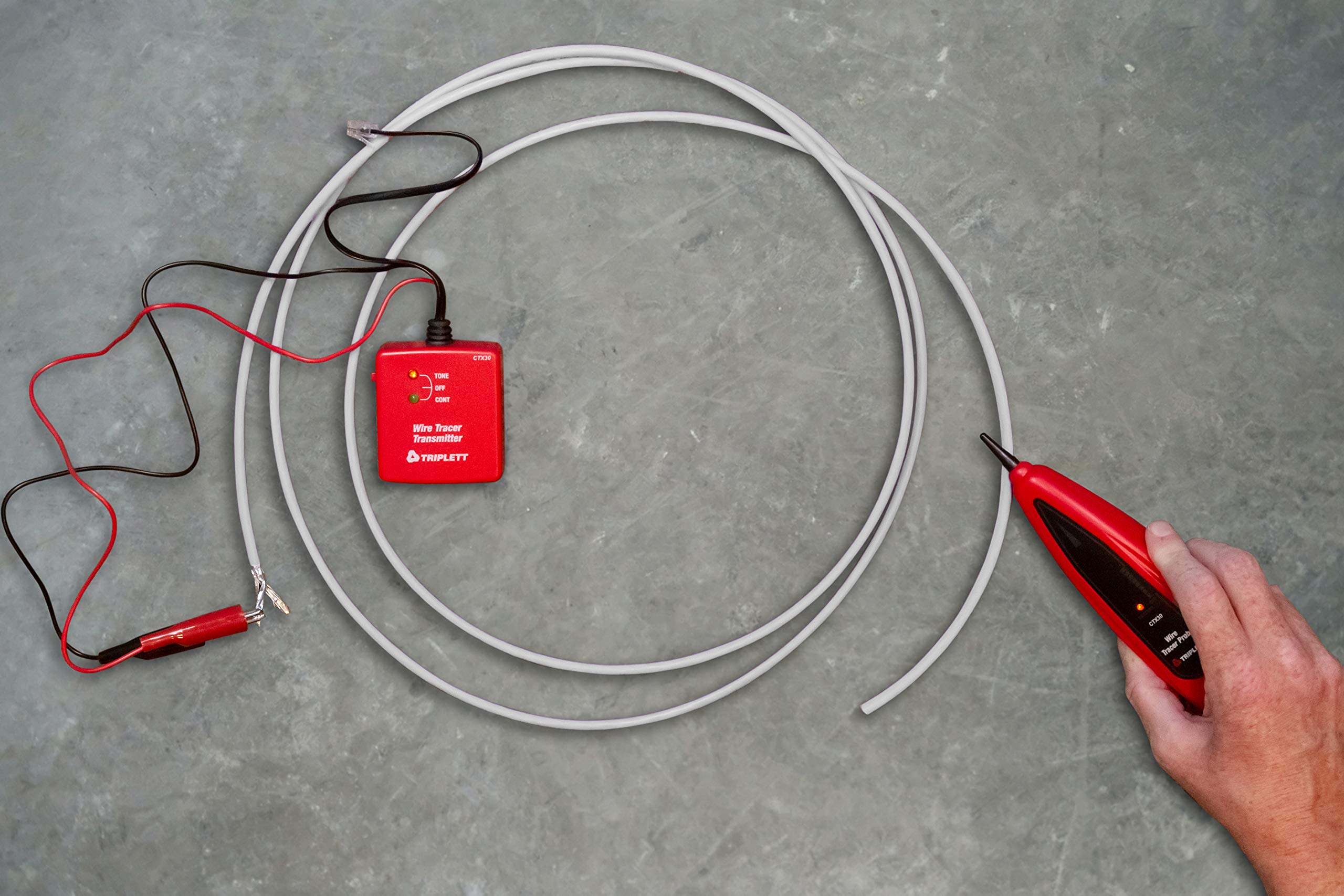
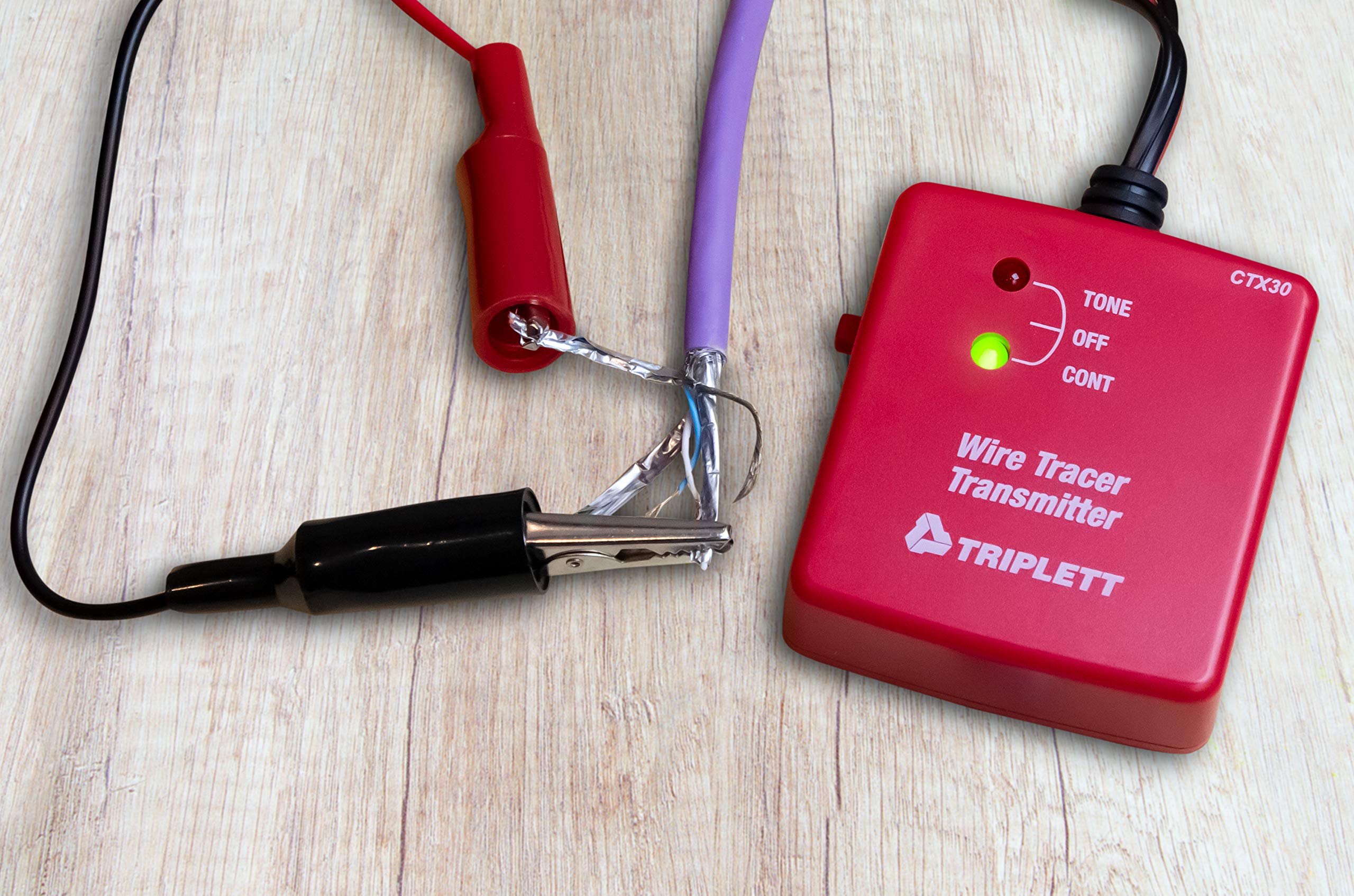
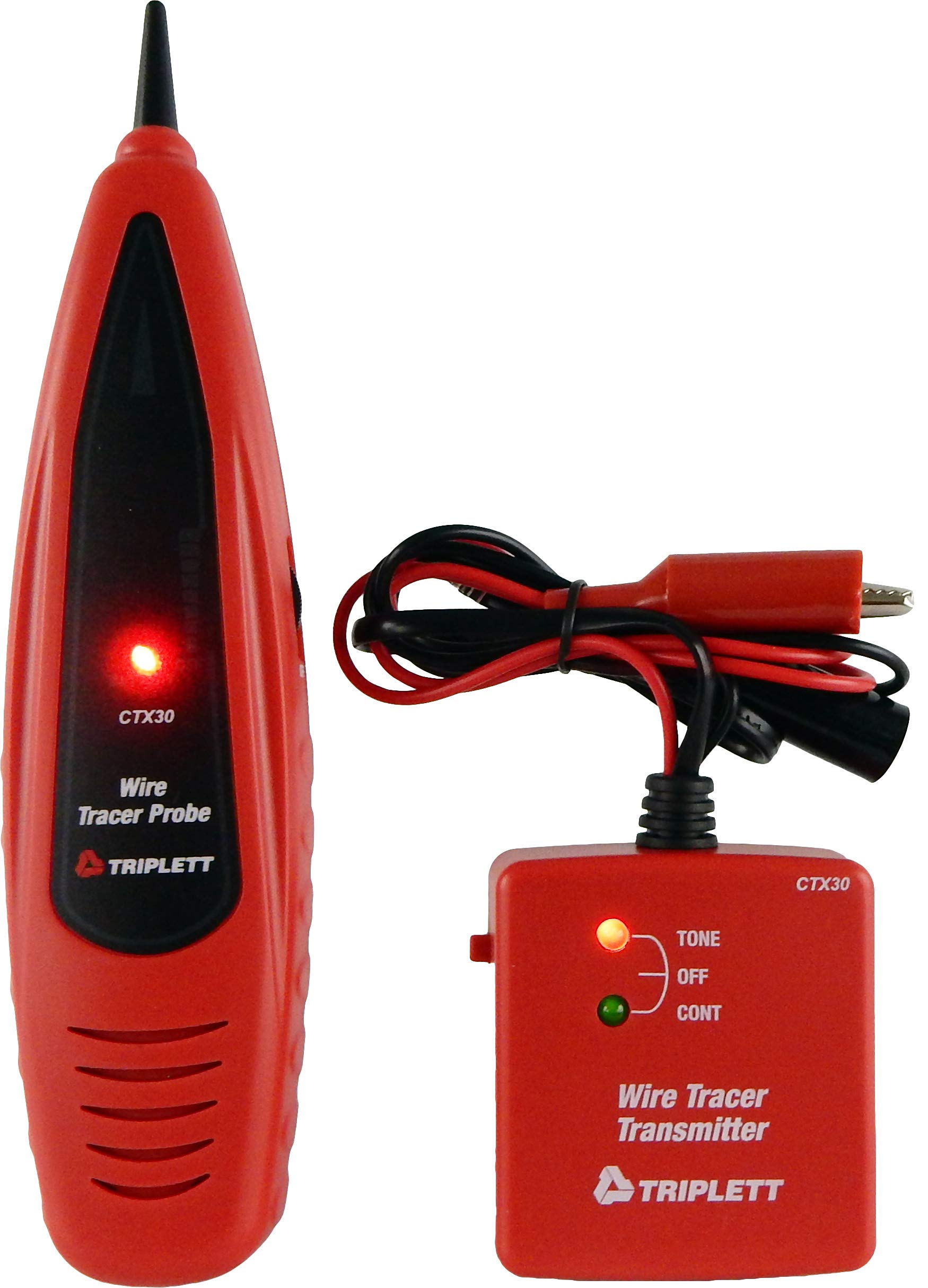
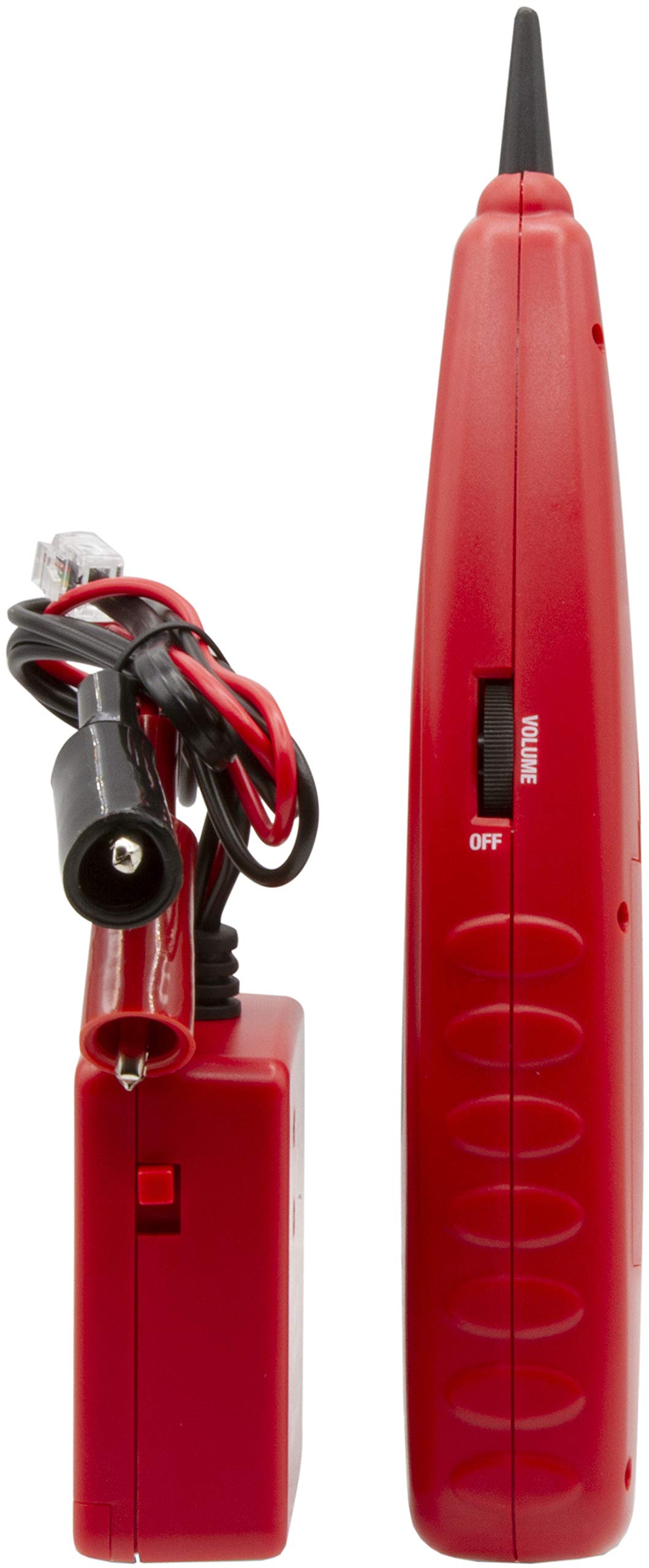
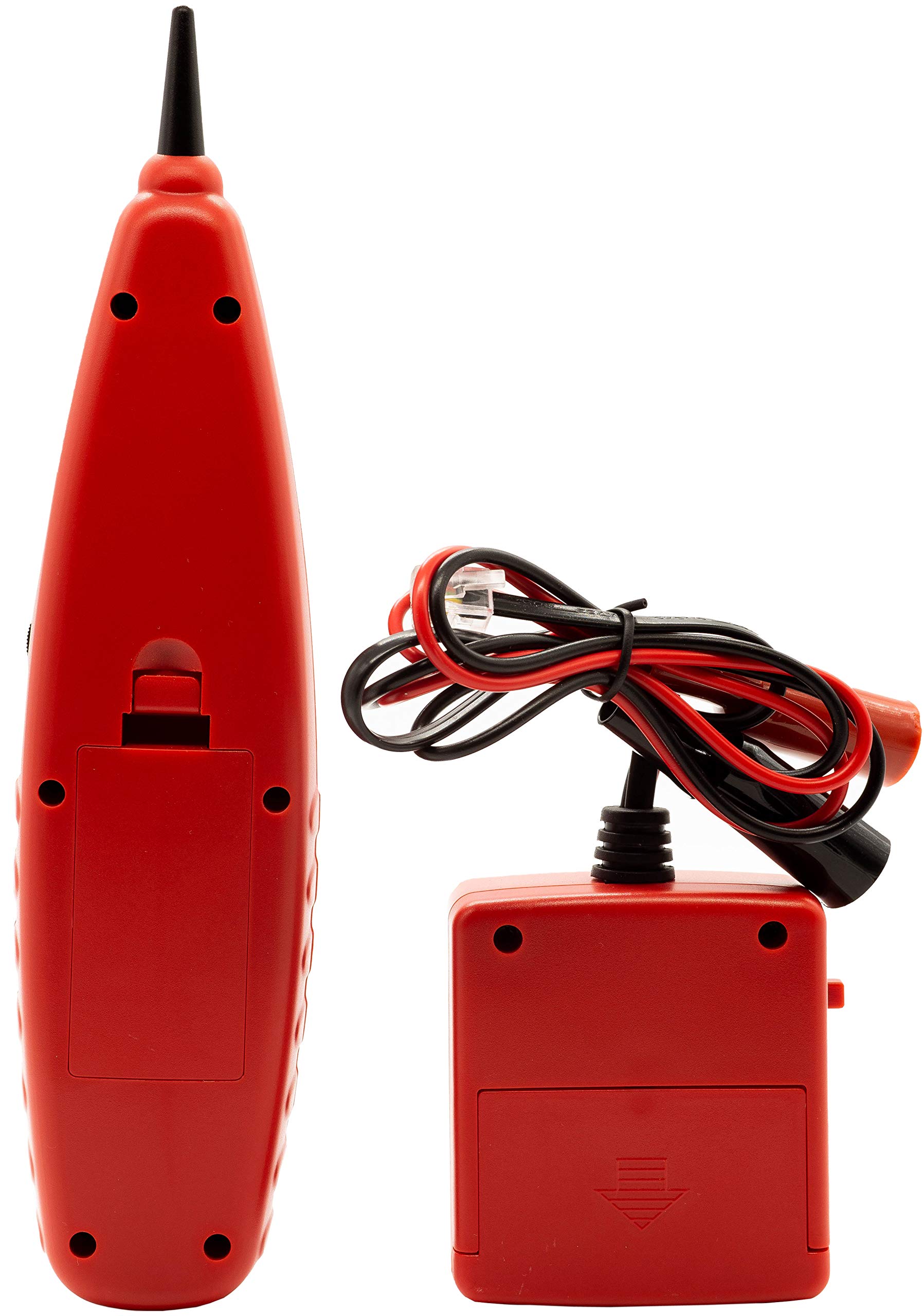
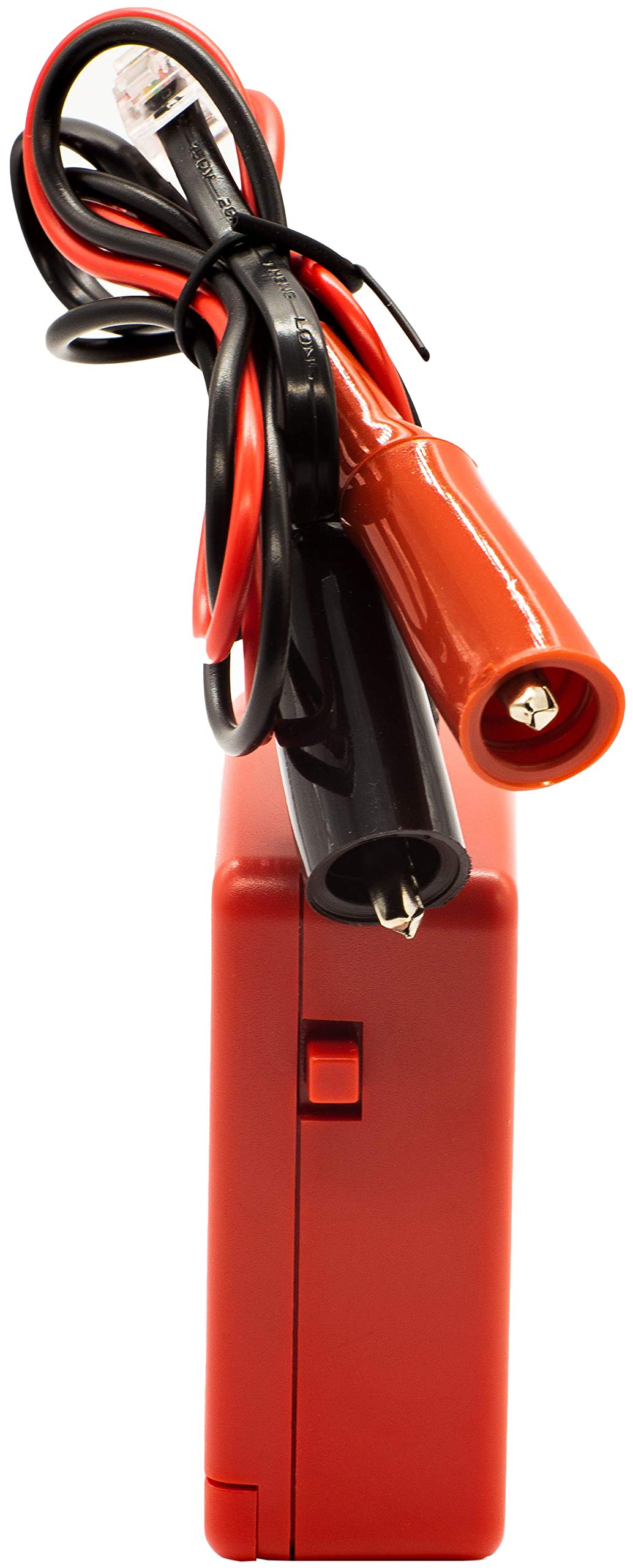
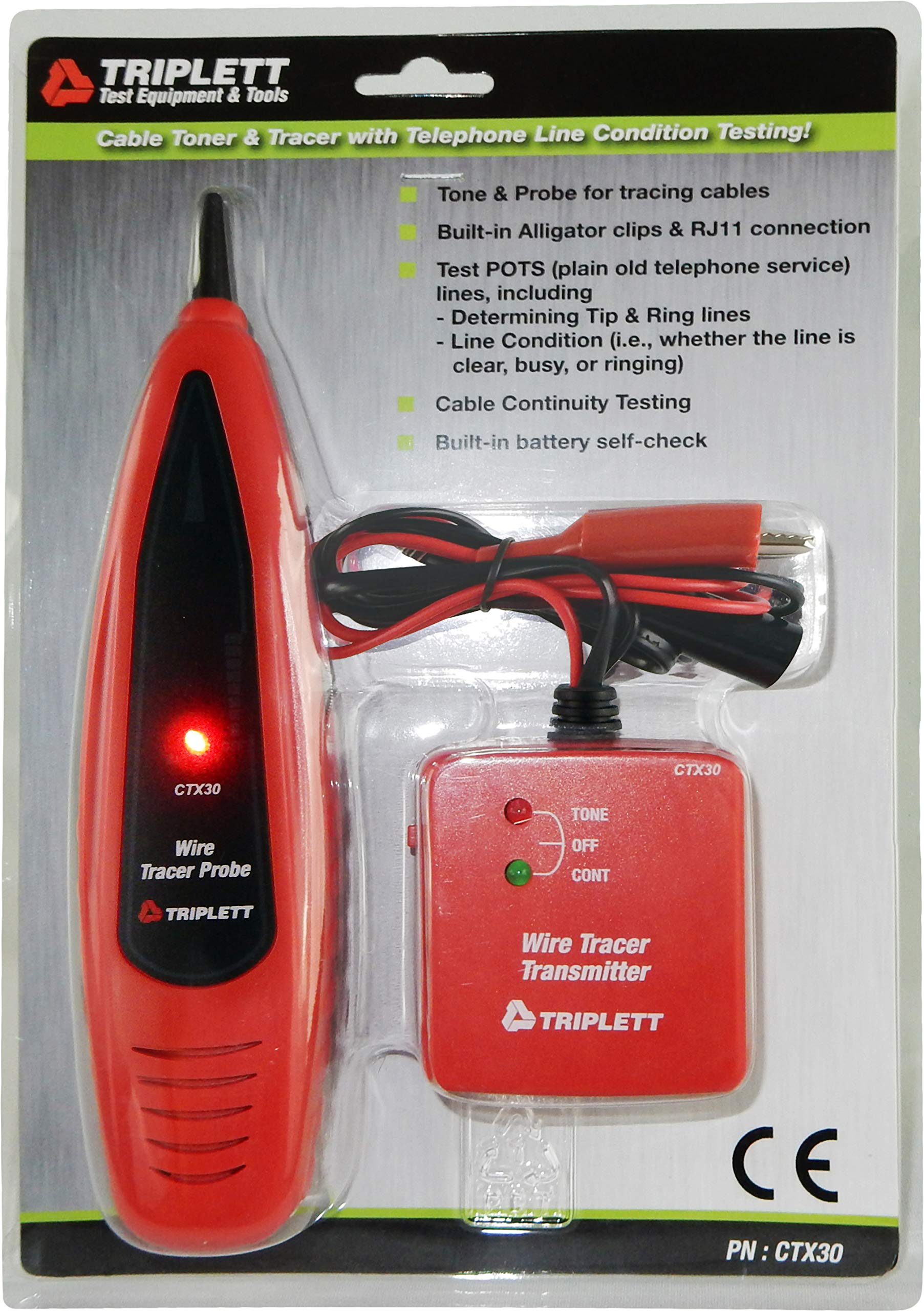
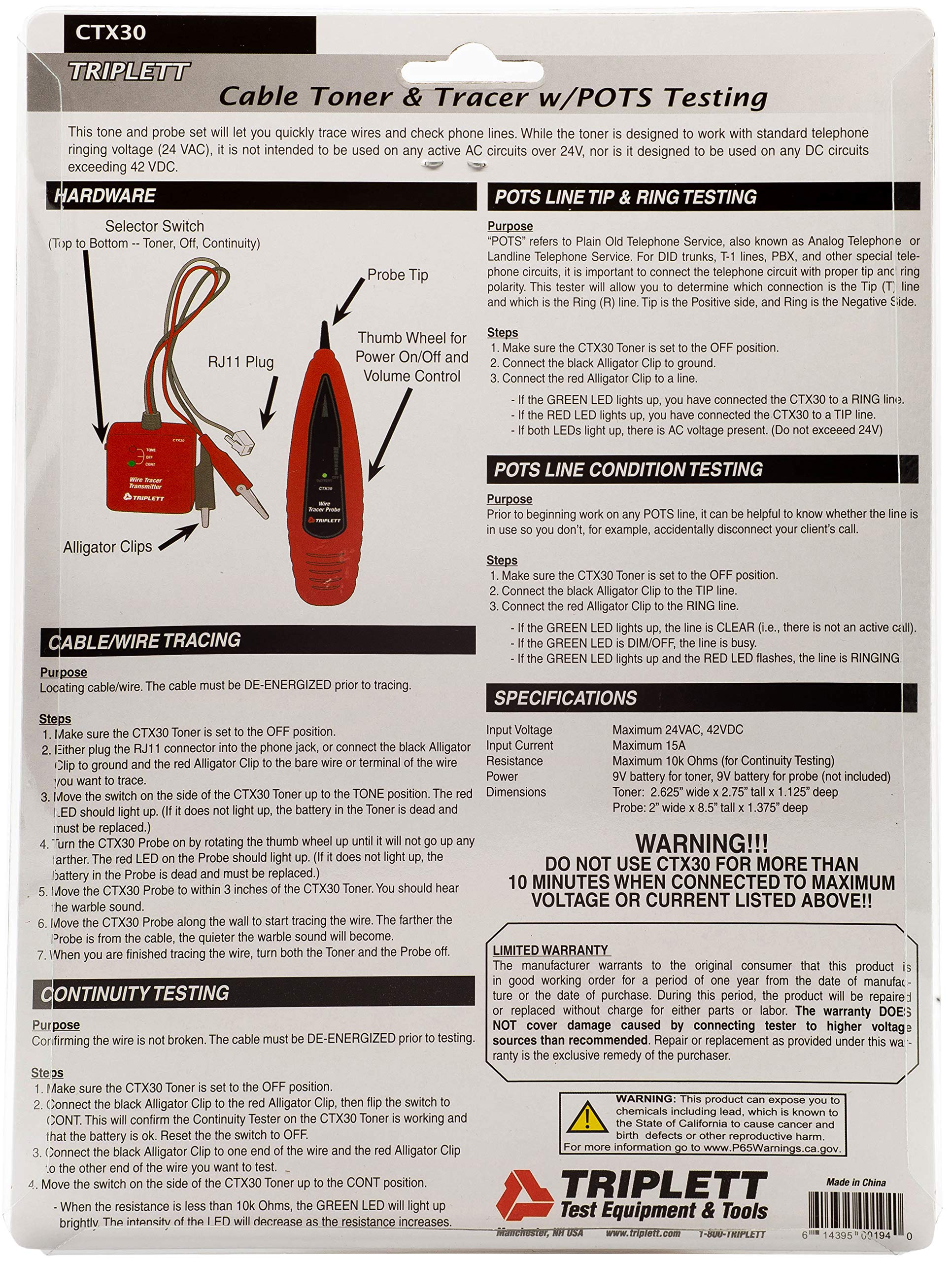
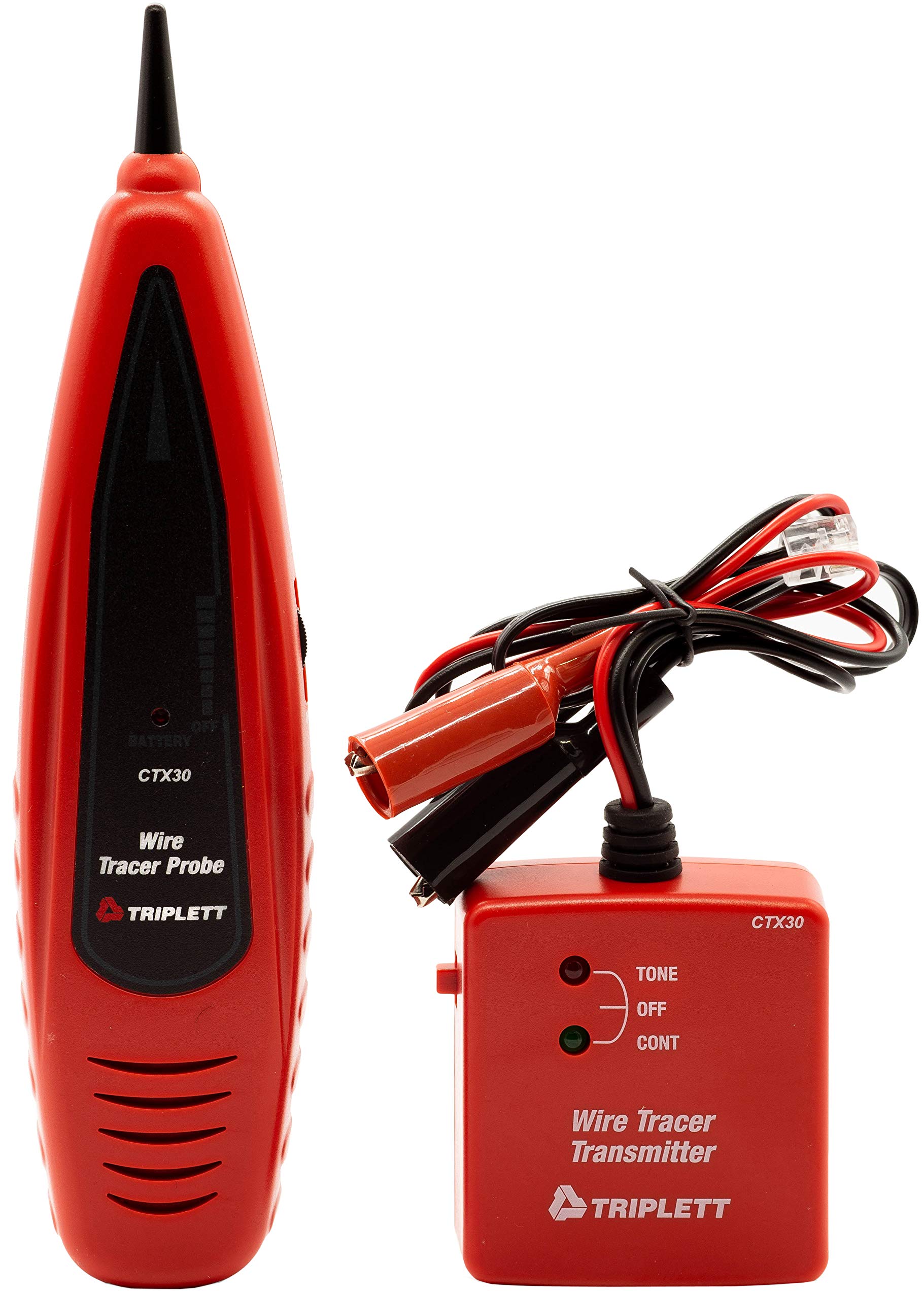
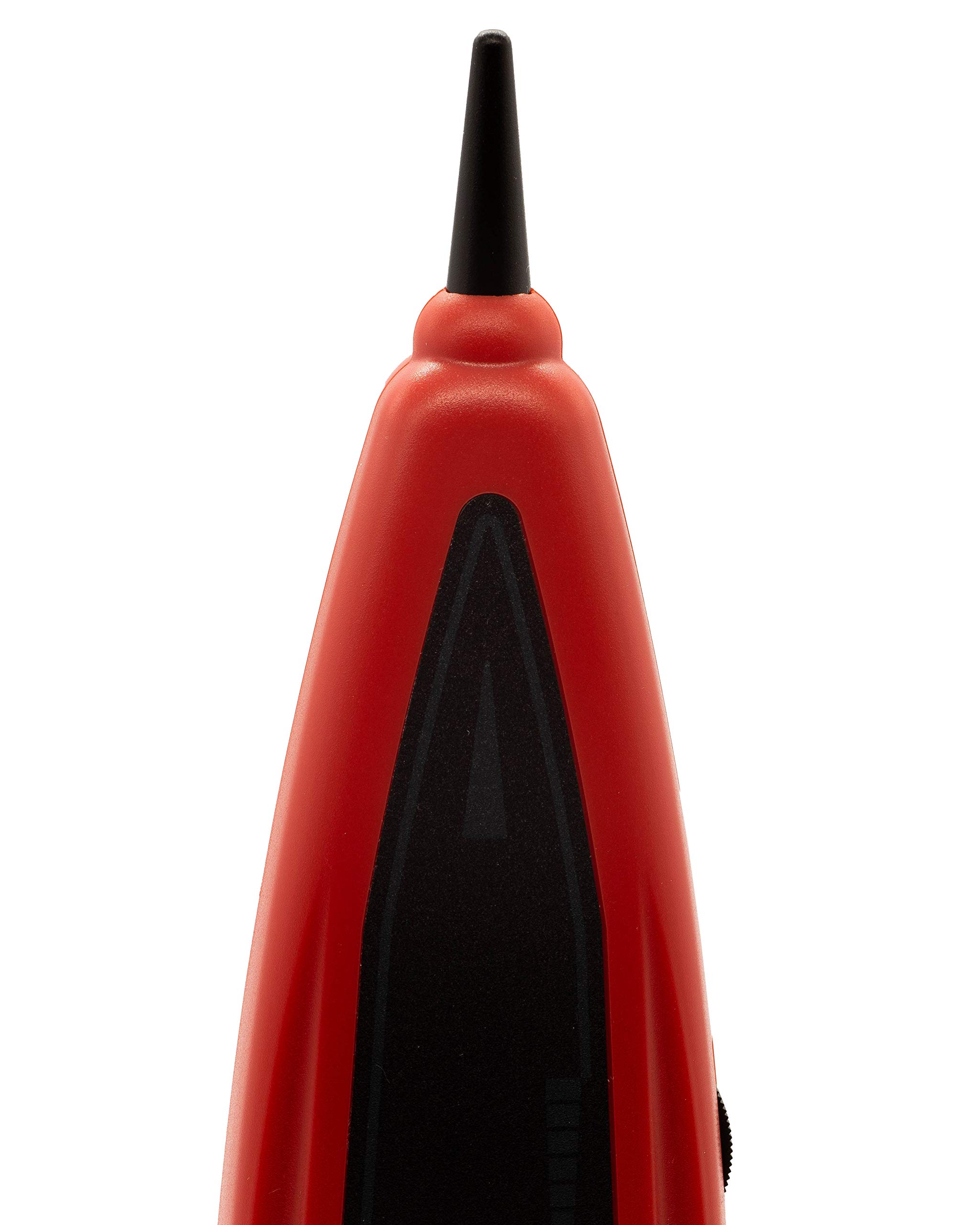
TriplettCTX30 Tone and Probe Wire Tracer and Circuit Tester
T**A
Hard to isolate wires without shorting
This tracer has a purpose, and kind of works well but at the same time will make you very frustrated. I had a Greenlee tracer 20 years ago that was more accurate but you needed to be very close to the wire. In the situation I needed the Hound for the break in the wire was somewhere in the ceiling or wall, but I wasn't sure. For following the general direction of a wire these can work as long as you don't have a bundle of wires running together as this operates with radio frequency, like a mini radio station that it uses the wire you connect to as an antenna. If the wires are bundled together the radio frequency bleeds into all the bundled wires and all the legs. To isolate the exact wire the only way you can do that is by turning the breaker off, hooking the black into one wire, usually the ground, and the red onto the wire you want to find. If you short the wire together it will change the tone. So if you have a 4 gang box with 4 4way switches then it is helpful in finding each wire as you can short them. In my exact situation I had drywallers at my house while I was not there. They ended up drywalling over an electrical outlet box that also just happened to be the main connection for the run back to the breaker box. I would disconnect the wire from the breaker and start following it in the ceiling and over to the wall that I knew I brought it down. The problem is the main run came down the wall and went into the drywall covered box, but then split two different directions for multiple outlets. The bleed from the RF signal would make you think the outlets in the chain had connection but they didn't. After virtually eliminating every other option I ripped the drywall off when the line was coming down the wall and the box was there.Just understand that if you are looking for a break in a line that it can be very difficult to find as the RF will jump the break and give you false readings.
K**N
Underwhelming at first, now it rocks my world.
When I first got this I was a bit underwhelmed by it. It seemed to bleed into other circuits and it confused me. My first impression was walking around a basement with a bad AM radio.However, I figured out that this thing absolutely rocks. After I tweaked the RF level on the sending unit once and it was good to go and haven't changed it since. I am using this every other week or so to trace wires both live and dead. I've used it to trace wire through non-metal conduit buried 8-12" underground. I've used it to chase crazy grounds that have broken continuity. I've traced through walls both new and old--and it's highly accurate in determining position.I have extremely high confidence that I can trace virtually any wire with this. I think this is the most useful, time-saving tool in my kit at this point.One caveat: this device is not useful for tracing to a a circuit breaker. Use a (much cheaper) breaker finder for that purpose. If you are tracing to a circuit breaker that is on, the RF will just bleed into all other circuits, which is exactly that this was designed to do.
D**L
Not good for tracing old home wiring...
Although this product sounds nice on paper, in actuality it doesn't work very well, especially when you are working with old home wiring that was not neatly organized. I was hoping this tool would help me locate a break in a hot wire that was causing a part of my house to lose power, but after playing around with this tool for a while those hopes quickly faded.My current house was built in the 40s, with cabling running across the attic that is low enough that you can barely see anything but insulation once you open the hatch. Unfortunately, the cabling that was run across the house was simply thrown in the attic and fished around to the appropriate place of the house. As a result, many cables are laid on top of each other and are not tied in properly to the right place (i.e. shared neutral).Because this product uses radio frequencies to detect the physical location of a cable, it is very prone to bleeding onto other things that are grounded. If I tried plugging both prongs in, then all the cables and outlets in the house would start alarming, despite setting the sensitivity and transmission levels on both the sender/receivers. On the other hand, only plugging the red pin into the hot slot would yield better results (only the circuit itself would alarm), although there are still a lot of issues with that approach:1. There is still a lack of ground - while the instructions attempt to explain this, I personally think it was poorly explained and the package does not offer you anything to create this ground connection. A ground connection is needed to make sure enough current can be created across the wire so the resulting signals can be amplified. However, the neutral wire or the ground wire cannot be used for this connection because the signals will then be induced on those wires as well, which will cause the entire cable to start alarming even if there was a circuit break on the hot wire itself. The proper way to create this ground would be to use a long extension cord and clip the end of the extension cord to some kind of ground rod (which is not included in this package). Without a ground connection, the signals don't travel very far and die down quickly with distance.2. The amplifier (hound) is an analog device - this was the biggest problem I had with this device. Similar to a radio that converts the signal to audio, the hound does exactly that (although a filter is integrated to filter the 60Hz line noise). What this means is that in addition to the signal you are looking for, you will also hear a lot of other interference that is not 60Hz (e.g. nearby AM radio stations). In fact, with the sensitivity level turned up, you can actually use the hound to listen to one of your local AM radio stations (although you can't really pick which one). Because there is no digital processing of the signals received, it is really up to the user (i.e. you) to determine what is signal and what is noise. The manual mentions a "null" to look for when looking for a cable, but that null also sounds very close to interference that you are seeking to tune out. Unless the ground connection is properly made, setting the appropriate sensitivity levels is also very difficult because the signals don't travel very far (e.g. do you turn up the sensitivity and start hearing noise, or turn down the sensitivity and not hear anything?). The visual indicator on the hound was close to useless because that's just a visual indicator of the input signal received and amplified by the hound, not the actual signal that is detected from the transmitter. If you started hearing AM radio from the hound, then the visual light indicator would blink to the radio talk host talking on that AM channel. Discerning how loud the "signal" is also a problem and can become quite frustrating when working with this tool (e.g. was it louder at this spot, or maybe this spot, or do they sound equally similar? In certain circumstances, they all just sound like loud beeps.)3. Bleeding to other cables is still an issue - as soon as you connect the black prong to a common ground, any nearby cables that share the same "ground" would cause the signal to bleed over. In my case, this defeats the purpose I got this tool for since overlapping cables that are not even on the same circuit would start to alarm, which makes locating the break location impossible. Although the signals that bled over to other cables tend to be lower, sometimes it makes you wonder whether it was the original signal that just got degraded due to distance, or if you are actually looking at a different cable altogether. Also, TrueTrace in this case won't do anything because it requires a dead cable pair that is intact.I recently purchased a NOYAFA NF-826 for about $100 and were surprised at how well it performs compared to the Triplett 3388, for starters:1. The unit does not use alkaline 9v batteries but instead is rechargeable by the USB port.2. The unit is all digital, and displays received signal intensity as a numeric value that can be adjusted upwards or downwards.3. It uses digital processing to determine what is signal and what is noise. For example, if you set your transmitter to use code A, the receiver will have to be able to decode the signal as code A before it would emit any intensity tones. The receiver also automatically decodes the right signal codes without manual intervention or setting. As a result, you do not have to listen to interference or any AM radio noises or interpret what you are trying to look for.4. Compared to the Triplett 3388 which only has a LED light for "voltage detected", the NF-826 gives you a numerical value when it is used on live mains similar to a multimeter (e.g. ~ 120V).5. The NF-826 also has an NCV function that is quite sensitive and you can use it to differentiate between neutral and live wires and see if a wire is "hot" (with the intensity displayed on the screen).6. The digital processing on the NF-826 and the numerical value assignments really help when it comes to tracing circuits, even when two prongs are plugged into the outlet (i.e. using the neutral wire as a ground). With this, I can differentiate between circuits inside the house easily because the different circuits generally give a very low to no numerical readout at all.7. The NF-826 comes with a ground rod that can be hammered into the lawn or grass and be used as a ground source. The Tripplett does not have such an accessory.8. The NF-826 accepts the standard detachable banana jacks that you can use your own probes where the Tripplett has non-detachable cables that you may need to use an adapter for such function.9. The NF-826 accepts up to 400v AC while the Tripplett can tolerate only up to 250v AC (probably not an issue though since most AC outlets would not exceed 240v, even internationally).I am guessing for the Tripplett it might be okay if you are simply trying to use it to locate wires that are not near any other cables with shared grounding. That being said, the Tripplett is not a cheap device, and for that price, you probably would be able to get the NF-826 (or the Mastech MS6818) for a similar or cheaper price that offers a much richer feature set. If you are looking for something to locate a breakage in the wire, I think the NF-826 or the MS6818 would probably be more suitable for that task compared to the Triplett, in my opinion.
B**E
Very Fragile
Just taking out of package the battery cover broke. it also uses an odd size battery that you cant get just anywhere.
E**I
Merci
Merci c utile
B**N
quality
price
C**N
Buy it !!!!
Good tracer , buy it !!!
Trustpilot
1 day ago
1 month ago
1 week ago
1 day ago